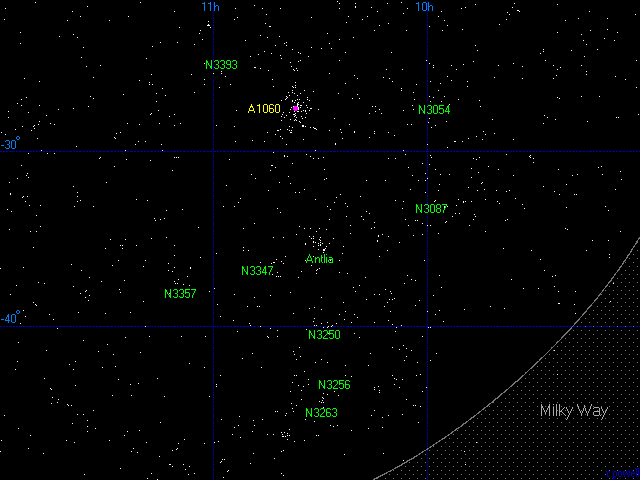
Together with the Centaurus supercluster, the Hydra supercluster is one of the two superclusters that are closest to the Virgo supercluster. The Hydra supercluster is about 100 million light years long, and it contains only one rich galaxy cluster - A1060 - also known as the Hydra cluster. This map below is a plot of every galaxy brighter than magnitude 16 (from the Principal Galaxies Catalogue) in the region of the sky centred on the Hydra supercluster. It is not an impressive supercluster, the only prominant features in this supercluster are the Hydra cluster and the rather smaller Antlia cluster.

Below is a list of the major clusters of galaxies in the Hydra Supercluster. Like the Virgo supercluster, the Hydra supercluster contains only one rich cluster: A1060 or the Hydra cluster. It has a richness class of 1, which means that it contains a similar number of galaxies to the Virgo cluster.
1 2 3 4 5 6 7
Abell Equatorial Redshift Distance Rich Notes
Number Coordinates z Mly
RA Dec
A1060 10 36.9 -27 32 .0114 158 1 Hydra cluster
|
Below is a list of some of the other major groups of galaxies in the Hydra Supercluster. These groups typically contain only about 10 large galaxies each. The only exception is the Antlia cluster which probably contains about 30 large galaxies.
1 2 3 4 5 6 7
Group Equatorial Redshift Distance Rich Notes
Name Coordinates z Mly
RA Dec
NGC3054 09 58.0 -27 24 .0077 105
NGC3087 09 59.0 -32 48 .0081 115
NGC3250/3318 10 28.0 -40 12 .0084 115
NGC3256/3261 10 28.0 -44 06 .0079 110
Antlia 10 30.0 -34 30 .0094 130
NGC3263/3366 10 32.0 -44 24 .0090 125
NGC3347 10 42.0 -36 48 .0092 130
NGC3393/3463 10 55.0 -25 18 .0119 165
NGC3557 11 10.0 -37 30 .0089 125
|
Column 1: The name/number of the cluster or group.
Column 2: The Right Ascension for epoch 2000.
Column 3: The Declination for epoch 2000.
Column 4: The redshift of the cluster.
Column 5: The distance in millions of light years assuming H=70km/s/Mpc.
Column 6: The 'richness' class of the cluster (for Abell clusters only).
Column 7: Additional names and notes.
References:
Abell G, Corwin H, Olowin R, (1989), A catalogue of Rich Clusters of Galaxies,
Astrophys J Supp, 70, 1.
Struble M, Rood H, (1999), A compilation of redshifts and velocity dispersions for
ACO clusters, Astrophys J, 125, 35.
Fouqué P, Gourgoulhon E, Chamaraux P, Paturel G, (1992), Groups of Galaxies within
80 Mpc, Astron Astrophys Supp, 93, 211.
Garcia A, (1993), General study of group membership. II. Determination of nearby groups.
Astron Astrophys Supp, 100, 47.
Giuricin G, Marinoni C, Ceriani L, Pisani A, (2000), Nearby optical galaxies: selection
of the sample and identification of groups. Astrophys J, 543, 178.
Below is a three-dimensional map of the Hydra supercluster. This map is an actual plot of the 250 largest galaxies in the supercluster. At the centre of the supercluster lies the dominant Hydra cluster - A1060. The nearest part of the supercluster to us is the region at the top-left where a lot of the other prominant groups of galaxies are.
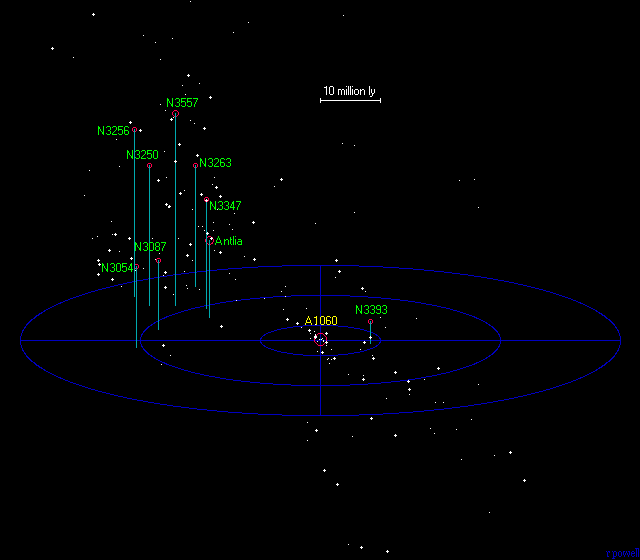
Together with the Virgo cluster and the Centaurus cluster (A3526), the Hydra cluster is one of the three largest clusters of galaxies within 200 million light years. Below is a photograph of the Hydra cluster. The galaxies here are visible as the various white blobs. Because the cluster is spread across 2 degrees of the sky there are a lot of faint foreground stars in this image. The bright orange star at the centre of the picture is HR4162 - a fifth magnitude red giant star 480 light years away.
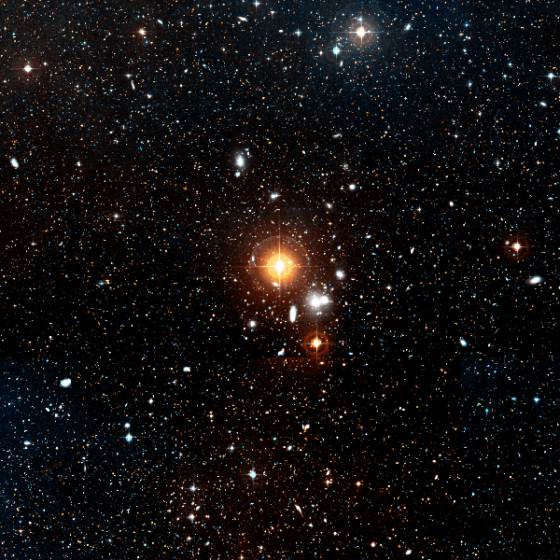
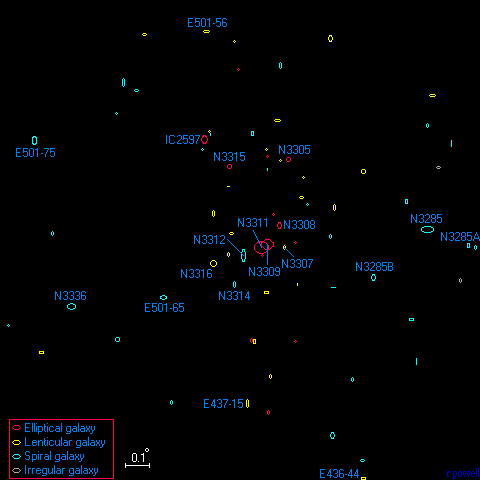
Right: this is a map of the Hydra cluster. This map shows the positions of 74 of the brightest galaxies in and around this cluster. The three dominant galaxies at the centre of the Hydra cluster are the two large elliptical galaxies NGC3309 and NGC3311 and the large spiral galaxy NGC3312. All three galaxies have a diameter of about 150 thousand light years.
Because it is not a major supercluster, the Hydra supercluster has not received a huge amount of attention. The Hydra supercluster has usually been studied together with its larger neighbour the Centaurus supercluster. A typical example is a paper by Costa, Numes, Pellegrini, Willmer, Chincarini, and Cowan who studied the distribution of galaxies in this region of the sky.
However most authors who have studied both the Hydra and Centaurus superclusters agree that these two superclusters are separate structures. In a second paper, da Costa, Willmer, Pellegrini, and Chincarini make it quite clear that they regard these two superclusters as seperate. The two superclusters are not unlinked however, they both connect to the Virgo supercluster and it is quite common to see this entire region referred to as the Virgo-Hydra-Centaurus supercluster.
Because it is one of the nearest rich clusters of galaxies, the Hydra cluster has been studied on many occasions. A typical example is a paper by Richter who catalogued the galaxies in the Hydra cluster in 1989, and a paper by Fitchett and Merritt who studied the motion of the galaxies in the cluster.
Although it is a poorer cluster, the Antlia cluster is also studied sometimes. A typical example is a paper by Hopp and Materne published in 1985. A more recent study was made by Nakazawa, Makishima, Fukazawa, and Tamura in 2000.
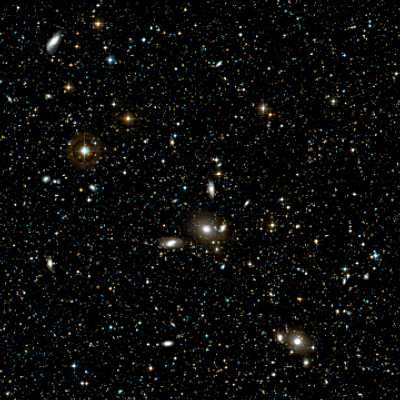
Although it is the second richest cluster in the Hydra supercluster, the Antlia cluster is not nearly as impressive as the Hydra cluster. It is a similar cluster to the Fornax cluster.
Like the Hydra cluster, the Antlia cluster does not photograph very well. The galaxies here are spread across 1 degree of the sky, so there are a lot of foreground stars in this image. The large central galaxy is NGC3268 - a massive elliptical galaxy.